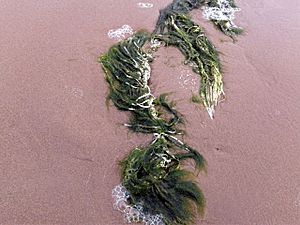Ulva paschima facts for kids
Quick facts for kids Ulva paschima |
|
|---|---|
 |
|
| Scientific classification | |
| Genus: |
Ulva
|
| Species: |
paschima
|
Ulva paschima is a type of green alga, which is a green seaweed. It belongs to the family Ulvaceae. This special seaweed is found only along the West Coast of India. Scientists first identified Ulva paschima in 2014. They used a method called molecular phylogenetics, which looks at the DNA of living things to understand how they are related. They specifically looked at something called "ITS sequences" to confirm it was a new species.
Contents
What Does Ulva Paschima Look Like?
This seaweed has parts called fronds, which are like its leaves. They stand upright and look like thin threads or filaments. They are a bright grass-green color. These fronds can grow from about 5 centimeters (2 inches) to 40 centimeters (16 inches) long. Most of the time, they don't have branches. They are usually shaped like tubes, but some parts can be flat like ribbons.
The seaweed attaches itself to rocks or other surfaces using special root-like structures called rhizoids. If the seaweed grows in water that isn't very salty, its fronds might have branches. But if it grows in the open ocean, where the water is saltier, its fronds usually don't have branches.
Inside the cells of Ulva paschima, there are green parts called chloroplasts. These are like tiny factories that help the seaweed make its own food using sunlight. Each cell has more than two special spots called pyrenoids within its chloroplasts.
Where Does Ulva Paschima Live?
Ulva paschima is found only along the West Coast of India. This means it is endemic to that area, and you won't find it naturally growing anywhere else in the world.
What Kind of Environment Does Ulva Paschima Like?
You can find this seaweed on rocks in the area between the high and low tide marks. This area is called the intertidal zone. It lives in both salty ocean water and in estuaries, which are places where rivers meet the sea. It can grow in water with different levels of saltiness, from very salty ocean water to slightly less salty water in estuaries.
The Life Cycle of Ulva Paschima
The adult Ulva paschima plants that produce spores and the ones that produce gametes look exactly the same. This can be a bit tricky!
Here's how its life cycle works:
- An adult plant, which has two sets of chromosomes (we call this diploid), creates tiny swimming cells called zoospores.
- These zoospores only have one set of chromosomes (they are haploid). They are made through a process called meiosis.
- When these zoospores settle down, they grow into new haploid plants. Some of these new plants are male, and some are female. They look just like the diploid adult plants.
- These haploid male and female plants then release their own special cells called gametes.
- When a male gamete and a female gamete join together, they form a new cell called a zygote.
- This zygote then grows and develops into a new diploid adult plant, starting the cycle all over again!
Images for kids


